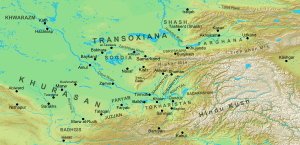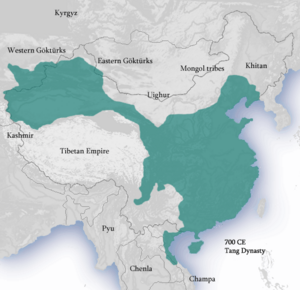Battle of Talas facts for kids
Quick facts for kids
|
|||||||
|---|---|---|---|---|---|---|---|
| Part of the Muslim conquest of Transoxiana | |||||||
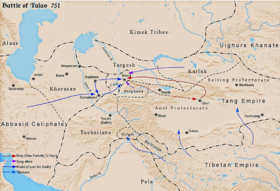 Movement into Central Asia: Chinese (Tang army)
Turks (Tang army, later Abbasid army)
Arabs (Abbasid army)
Tibetans (Tibetan army)
|
|||||||
|
|||||||
| Belligerents | |||||||
|
|
||||||
| Commanders and leaders | |||||||
|
|
||||||
| Strength | |||||||
| 30,000 Abbasid troops | 10,000 Tang troops | ||||||
| 20,000 Turkic mercenaries | |||||||
| Casualties and losses | |||||||
| Unknown | Unknown | ||||||
The Battle of Talas was a major fight in 751 AD. It happened between the Abbasid Caliphate and the Tibetan Empire on one side, and the Tang dynasty of China on the other. In July 751, these armies met near the Talas River. They were fighting for control of important areas around the Syr Darya river.
Chinese records say the battle was stuck for a few days. But then, a group of about 20,000 Karluk Turks who were fighting for the Tang army switched sides. This changed everything and helped the Abbasids win. This defeat stopped the Tang dynasty from expanding further west. However, China and the Abbasids later restarted diplomatic relations.
Contents
Where Did the Battle of Talas Happen?
The exact spot of the battle isn't fully known. But most people believe it was near the cities of Taraz and Talas. These cities are on the border of what is now Kazakhstan and Kyrgyzstan. The Chinese name for the area, Dáluósī, was first written down by a traveler named Xuanzang.
Why Did the Battle Happen?
The towns along the Silk Road in Central Asia were very important. They were once controlled by the Türgesh people. But in the late 600s, the Türgesh fell into chaos. China's Tang dynasty took control of the Tarim Basin in 692. These oasis towns became a big source of money for the Tang.
Around 705, the Umayyad army, led by Qutayba ibn Muslim, started conquering towns along the Silk Road. They took cities like Bukhara and Samarkand. This pushed their empire eastward. At the same time, a Türgesh leader named Suluk began uniting his tribes.
Early Conflicts in Central Asia
The Muslim, Tibetan, and Tang armies had some clashes before Talas.
- In 715, the Umayyad and Tibetan armies helped put a new king on the throne in Fergana. The old king asked China for help. About 10,000 Tang soldiers helped him get his throne back.
- In 717, Arab Umayyad soldiers and the Tibetan Empire attacked Aksu City. But the Tang army defeated them in the Battle of Aksu.
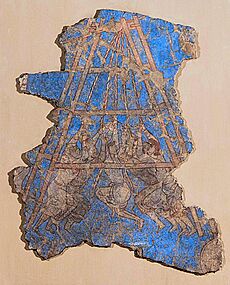
The Tang emperor didn't want to recognize Suluk as a powerful leader. So, Suluk and the Tibetans invaded the Tarim Basin. But they were pushed back by the Tang. Suluk's soldiers often fought against both Umayyad and Tang control.
The Rise of the Abbasids
In 747, the Tang general Gao Xianzhi took control of the Gilgit region. This was after he fought the Tibetan empire. In 748, a Persian general named Abu Muslim started a revolution. This led to the fall of the Umayyad Caliphate. In 750, Abu al-'Abbas al-Saffah became the first Abbasid caliph.
The Tang general Gao Xianzhi and the Abbasid general Ziyad ibn Salih eventually met. This happened because the kings of the Silk Road towns Tashkent and Ferghana asked their empires for help. Gao Xianzhi attacked and took control of Tashkent. Ziyad ibn Salih escaped and gathered more troops. He then marched to fight the Tang army. Gao Xianzhi also gathered an army, including Karluk Turks. The Karkota dynasty from Kashmir also helped the Chinese.
The Battle Itself
We don't know the exact number of soldiers in the battle. Chinese sources say the Abbasid army had 200,000 soldiers, including their Tibetan allies. Arab records say the Chinese had 100,000 soldiers. But Chinese sources also say the Tang army had 10,000 infantry and 20,000 Karluk mercenaries.
Early Chinese records say about 30,000 or 20,000 people died. An early Arab record says 50,000 died and 20,000 were captured.
How the Armies Fought
In July 751, the Muslim and Tang armies met by the Talas River. The Muslim general set up his army with archers in front, then spearmen, and heavy cavalry behind them. Gao Xianzhi set up his army similarly. He had crossbowmen and spearmen in front. Lighter troops were behind them. The Karluk Turks were on the far sides of his army.
For the first three days, the Chinese attacked first. Their archers and crossbowmen were very accurate and caused a lot of damage. The Arab archers had to fall back. The Arab spearmen then charged forward. The Tang heavy infantry were better armored and pushed the Arab infantry back. The Muslim general tried to help his infantry by sending his heavy cavalry to attack the Chinese sides. But this attack didn't work.
The Karluk Betrayal
On the fourth day, something big happened. The Karluk mercenaries, who were fighting for the Chinese, betrayed them. They attacked the Tang army from the sides. At the same time, the main Abbasid forces attacked from the front.
The Tang army couldn't hold their ground. Their commander, Gao Xianzhi, knew they were losing. He managed to escape with some of his soldiers, helped by Li Siye. Out of about 10,000 Tang troops, only 2,000 made it back to their territory. Even though they lost, Li Siye caused heavy losses to the pursuing Arab army.
What Happened After the Battle?
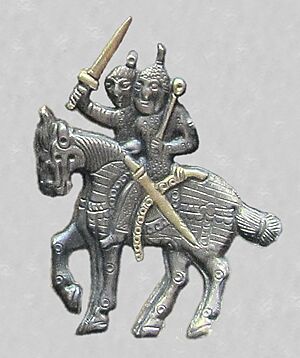
According to one Arab source, the Abbasid general Abu Muslim captured 5,000 Chinese prisoners. He also took supplies from the Tang army camp. After the battle, the Arabs made the Chinese army leave the Gilgit region.
The An Lushan rebellion in China, which started a few years later, ended the Tang presence in Central Asia. This forced them to leave their western borders. Because the Arabs didn't push further after the battle, Talas itself didn't remain a very important strategic place.
Karluk Conversion to Islam
After the battle, a small number of Karluks became Muslim. But most of them didn't convert until the mid-900s. This was when Sultan Satuq Bughra Khan started the Kara-Khanid Khanate. This happened long after the Tang dynasty had left Central Asia.
Relations Between China and the Abbasids
The Abbasid caliph Al-Mansur sent diplomatic groups to China regularly. These groups were known in China as Khayi Tashi (meaning "Black Clothes"). The An Lushan rebellion in China, which lasted from 755 to 763, weakened the Tang dynasty. This gave the Arabs a chance to expand more into Central Asia. The Tibetans also took over the area between the Arabs and China.
In 756, Al-Mansur even sent 3,000 soldiers to help the Tang emperor fight the An Lushan rebellion. Despite the battle, relations between China and the Abbasids didn't get worse. The Abbasids continued to send groups to China without stopping.
The Tang dynasty did recover its power later on. They even destroyed the Uyghur Khaganate in Mongolia between 840 and 847. However, another rebellion, the Huang Chao rebellion (874–884), finally destroyed the Tang dynasty's power. This rebellion caused a lot of damage and led to the end of the Tang dynasty in 907. China then entered a period of many different kingdoms.
Trade and Buddhism
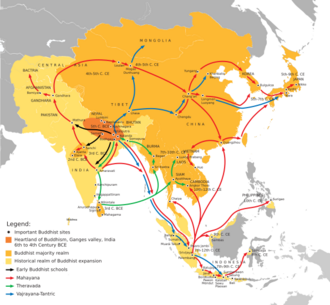
Talas is in modern-day Kyrgyzstan and was part of the Silk Road. This network of trade routes connected China to the West. Before the Battle of Talas, Buddhists controlled much of these roads. After the battle, Central Asian Buddhism started to decline in the region.
However, the Battle of Talas did not completely end Buddhism or Chinese influence. The Buddhist Kara-Khitan Khanate later defeated the Seljuk and Kara-Khanid Turks in 1141. They took over a large part of Central Asia. The Kara-Khitans even brought back the Chinese system of government. They used Chinese as an official language.
Papermaking
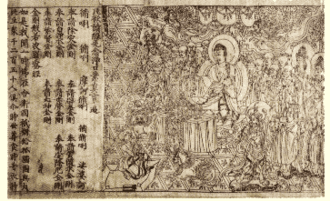
Some stories say that Chinese prisoners captured at Talas in 751 taught people in Samarkand how to make paper. They supposedly made paper while living in Abbasid lands. However, this story is probably not true. Paper was already used in Central Asia by the 700s. Old paper pieces from the 4th and 5th centuries have been found in places like Turpan.
Historians believe that papermakers were already active in Central Asia for a long time. They had learned to use cloth scraps instead of plant fibers to make paper. No Chinese records mention this technology transfer through prisoners. Also, no early Arab records talk about it.
A Chinese traveler named Du Huan, who was captured at Talas, wrote about his travels. He said that Chinese prisoners practiced crafts like silk weaving in Abbasid territory. Chinese paper remained a valuable product for centuries. The first paper mill in Baghdad was built in 794–795. After that, paper was made all over the Islamic world and started to replace papyrus.
Why Was This Battle Important?
Historians have different ideas about how important the Battle of Talas was.
- Russian historian Vasily Bartold thought it was very important. He believed it decided whether Chinese or Muslim culture would be stronger in Central Asia.
- However, early Arab historians didn't mention this battle much.
- Professor Denis Sinor said that China's power in Central Asia ended because of problems within the Western Turkic Khaganate, not because of the Battle of Talas.
- Chinese historian Bai Shouyi said that Chinese expansion in Central Asia didn't stop after the battle. He noted that China still launched attacks and that some Central Asian states continued to ask China for help against the Arabs.
- Professor Xue Zongzheng believes that other than the spread of papermaking, the battle didn't cause big changes in politics or population. He thinks Tang influence in Central Asia actually grew stronger after 751.
|


